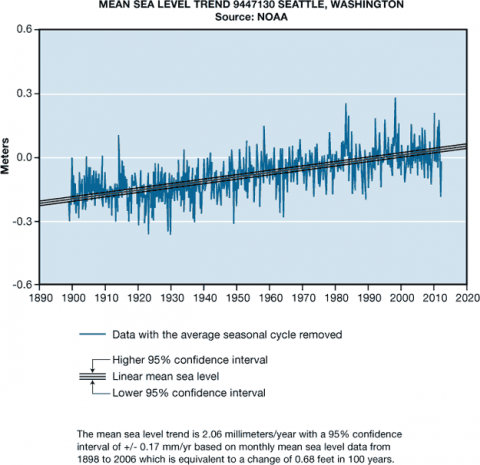Scientists examine the 'time of emergence' for climate change in Puget Sound
Climate change, like politics, is local. "At least that is how you have to look at the impacts," says Encyclopedia of Puget Sound topic editor Amy Snover. Snover is the Director of the Climate Impacts Group at the University of Washington and has been conducting research on the expected 'time of emergence' for climate change in the Puget Sound region.
Climate change, like politics, is local. "At least that is how you have to look at the impacts," says Encyclopedia of Puget Sound topic editor Amy Snover. Snover is the Director of the Climate Impacts Group at the University of Washington and has been conducting research on the expected 'time of emergence' for climate change in the Puget Sound region.
Time of emergence refers to the point at which the effects of climate change emerge from the background noise and become evident and clear. By now, many of the projections for global temperature and sea level rise are familiar. But when—and how—will we start experiencing them here? Or has that time already come?
In a recent talk at the University of Washington Tacoma, Snover made the point that understanding broader climate signals like global temperature averages, while important drivers of the system, aren't that helpful when planning for the impacts in Puget Sound. Consider sea level rise, she says. Sea level rise in Seattle is expected to vary from 7 inches to 56 inches over the next 50 to 100 years, depending on who you talk to and where you are located. And that is within a single city. The complexity of the shoreline and any number of other factors make a single prediction for Puget Sound impractical, and for the most part impossible.
Meanwhile, planners and scientists are being asked to consider climate change in their research and their decisions. How can this be done in a meaningful way?
Snover has been developing a tool that might help. She and her team have been analyzing existing data and climate change projections for Puget Sound and placing them a in a decision context. This work is being supported through a grant from the Environmental Protection Agency, and some of it will eventually appear on the Encyclopedia of Puget Sound. The tool will help planners calculate factors like risk tolerance and vulnerability as they make decision about how to respond.
In this sense, time of emergence is context-specific—a federal agency managing an endangered species will likely tolerate less risk than a group of engineers building a dock, for example. If changing conditions could cause a species to die out while engineers could simply make their dock higher, the time of emergence (in other words, the time of serious impact) would be sooner for the species.
It's a new approach to one of the world's most pressing issues. The concept was first developed by researchers looking at global systems, but Snover's work in Puget Sound is the first time this approach has been taken at the local ecosystem level. The tool is still fairly coarse and imprecise, she says, but she hopes that it can eventually be used to identify priority areas for more detailed analysis to support climate risk reduction.
Additional resources:
Related story: Sea level rise could release toxics into Puget Sound
Climate change impacts and adaptations in Washington State
Climate change impacts on water management in the Puget Sound region
Recent blog posts
PSI eNews Archives

This Encyclopedia's parent organization, the Puget Sound Institute, also publishes an email newsletter. Visit the PSI blog to subscribe to the PSI eNews or peruse past issues.






